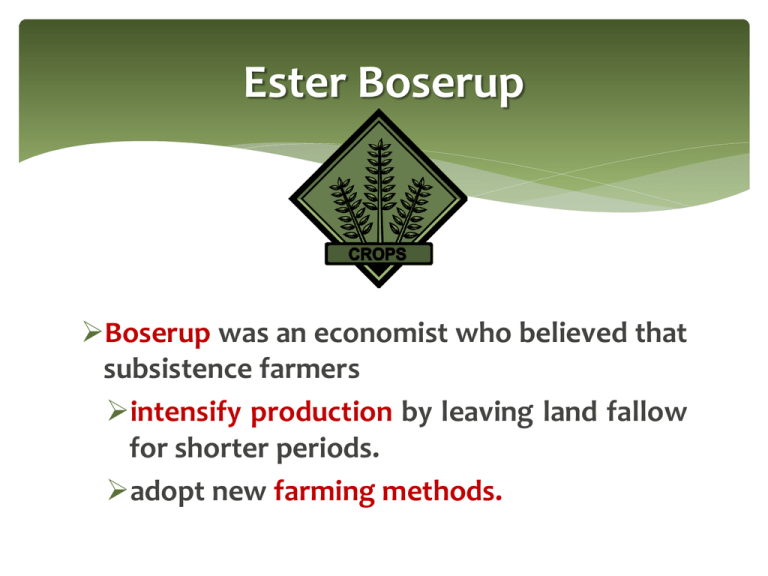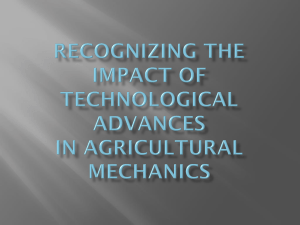Mediterranean agriculture is practiced in the following places
advertisement

Ester Boserup Boserup was an economist who believed that subsistence farmers intensify production by leaving land fallow for shorter periods. adopt new farming methods. Ester Boserup In order to farm land more efficiently, plows must be used. more weeding must take place. more ditches for irrigation must be dug. Ester Boserup The increase in population provides more people for weeding and digging ditches, so yield per acre increases, and land may be left fallow for shorter periods of time. COMMERCIAL FARMING: SUBREGIONS Commercial Agriculture Commercial farmers are part of a large, complex economy that includes industrial and service sectors as well. Commercial Agriculture: Categories Intensive Types Dairy farming Truck farming Extensive Types Large grain farms Livestock farms Commercial Agriculture: Mixed Crop and Livestock Farming Mixed crop and livestock farming is the most common form of commercial agriculture in: the United States west of the Appalachian Mountains. much of Europe from France to Russia. Commercial Agriculture: Mixed Crop and Livestock Farming Farmers grow crops and raise livestock on the same land spread, with most of the crops fed to animals rather than people. Most income comes from the sale of animal products such as: beef milk eggs Commercial Agriculture: Mixed Crop and Livestock Farming Most farmers practice crop rotation where each field is planted on a planned cycle. Different crops take different nutrients from the soil. Commercial farmers make efficient use of soil. Commercial Agriculture: Mixed Crop and Livestock Farming At any given time, commercial farmers will have almost half of their fields planted but with different crops from previous years. Commercial Agriculture: Mixed Crop and Livestock Farming Example of crop rotation: One cycle might consist of cereal grains (e.g. oats). A second cycle might feature a root crop (e.g. turnips). A third cycle would be a “rest” crop such as clover. It restores the field but may be eaten by cattle. Then the farmer can start over with a cereal grain. Commercial Agriculture: Dairy Farming Dairy farms must be closer to market than other products because milk spoils quickly. A ring of milk production called a milkshed surrounds a major city. Commercial Agriculture: Dairy Farming Today refrigerated rail cars and trucks have extended the reach of the milksheds so that nearly every farm in the U.S. Northeast and Northwest Europe is within the milkshed of at least one urban area. Commercial Agriculture: Dairy Farming Dairy farms also produce butter and cheese, with many specializing in one product or another. Since cheese and butter keep fresh longer than milk, farms further away from urban centers tend to favor these products over milk. Commercial Agriculture: Dairy Farming A Look at New Zealand… New Zealand is the world’s largest producer of dairy products. New Zealand farmers devote only a small share of their work to liquid milk because they are too far away from North America and Western Europe to hold the milk market. New Zealand Commercial Agriculture: Dairy Farming Dairy farmers usually do not sell their products directly to consumers but to wholesalers or to butter and cheese manufacturers. Commercial Agriculture: Dairy Farming The number of dairy farms has decreased significantly since 1980. Dairy farmers cite long work and too little profit as reasons for giving up their farms. HOWEVER, overall dairy production has risen, indicating that farms still in existence are producing more. Commercial Agriculture: Dairy Farming A disadvantage of dairy farming is the expense of feeding cows in winter. Dairy farmers must purchase all feed, making it less likely that they will make a profit. Dairy farming is also labor intensive. For example, cows must be milked twice daily. Commercial Farming: Grain Farming The most important grain –producing areas in the world are in three regions in the United States. Commercial Farming: Grain Farming Region One: winter wheat area Kansas, Colorado, Oklahoma The crop is planted in the autumn, survives the winter, and ripens the following summer. Commercial Farming: Grain Farming Region Two: spring wheat area The Dakotas Montana In this region, winters are too severe for winter wheat. Region three: the Palouse Region Washington state Commercial Farming: Grain Farming Other grain-producing countries: Canada Australia Argentina France United Kingdom Commercial Farming: Grain Farming Large-scale grain production, like other forms of commercial agriculture, is heavily mechanized on large farms. Commercial Farming: Grain Farming Much wheat finds its way into the international market, where it serves as the world’s leading export crop. As a result, the prairies of North America are often referred to as the “world’s breadbasket.” States likes Wyoming and Nebraska that lie between regions often are able to produce both winter and spring wheat. Major Grain-producing Regions of the U.S. Commercial Farming: Livestock Ranching Ranching is the commercial grazing of livestock over an extensive area. It is often practiced in arid or semi-arid regions where climate conditions make crop production impractical. Commercial Farming: Livestock Ranching Cattle ranching extends over much of the western United States, where the patterns of life associated with it have shaped the popular image of the West through stories of cowboys, round-ups, and trailherding. Commercial Farming: Livestock Ranching By the late 19th century, cattle ranching became more sedentary as more railroads covered the landscape and farmers claimed more western lands. Commercial Farming: Livestock Ranching In South America, a large portion of the pampas (prairie) of Argentina, southern Brazil, and Uruguay are devoted to grazing cattle and sheep. Brazil Argentina Uruguay The shaded area on the map shows where livestock ranching is prevalent in South America. Commercial Farming: Livestock Ranching Ranches in the following places are more likely to raise sheep than cattle: Australia New Zealand Middle East South Africa Commercial Farming: Livestock Ranching Irrigation has allowed conversion of ranch land to crops, with the remaining ranches experimenting with new methods of breeding, feeding, and watering in order to stay profitable. Commercial Farming: Livestock Ranching While livestock raised in the U.S. is sold primarily in the domestic market, livestock raised in other areas is more likely to be exported to high consumption developed countries. Commercial Farming: Mediterranean Agriculture Mediterranean agriculture is practiced in the following places: lands that border the Mediterranean Sea California Central Chile southwestern part of South Africa southwestern Australia Commercial Farming: Mediterranean Agriculture These areas share a similar physical environment. They: border seas. are on the west coasts of continents. have moisture provided by prevailing sea winds. have moderate winter temperatures. have hot and dry summers. Commercial Farming: Mediterranean Agriculture Horticulture is the growing of fruits, vegetables, and flowers. Horticulture forms the commercial base of Mediterranean agriculture. Commercial Farming: Mediterranean Agriculture Mediterranean Sea California The most important cash crops for this region are: This region produces grapes, (wine), citrus fruits, and tree nuts. This region produces a wider variety of crops because of the extensive use of irrigation. olives grapes Two-thirds of the world’s wines are produced here. Commercial Farming: Commercial Gardening and Fruit Farming Commercial gardening and fruit farming predominate in the U.S. Southeast, a region with a long growing season and humid climate. The region also has accessibility to the markets of the Northeast. Commercial Farming: Commercial Gardening and Fruit Farming This type of agriculture is often called truck farming. “Truck” originally meant “bartering” in the English language. Truck farms usually rely on: machinery fertilizers migrant workers Commercial Farming: Commercial Gardening and Fruit Farming Products from truck farms include: apples asparagus cherries lettuce mushrooms tomatoes Some produce is sold fresh to consumers but most is sold to large processors for canning or freezing. Commercial Farming: Plantation Farming A plantation is a large farm that specializes in one or two crops and is found today in: Latin America Africa Asia Commercial Farming: Plantation Farming Almost all crops are raised for export to high-consumption developed countries. These exports are called cash crops because they are raised to make money for their owners. Commercial Farming: Plantation Farming Crops that are usually grown on plantations include: cotton sugarcane coffee rubber tobacco Commercial Farming: Plantation Farming Plantations are colonial legacies that persist in poorer, primarily tropical, countries along with subsistence farming. Until the 19th century, slave labor was employed, but today the workers are paid, although their room and board constitutes a large part of their salaries. Commercial Farming: Plantation Farming Today many plantations in former colonies are still owned by Western corporations or individuals. Key Terms to Remember from this Session Less developed countries More developed countries Subsistence agriculture Commercial agriculture Agribusiness Intensive subsistence agriculture Wet rice Labor intensive agriculture Shifting cultivation “slash and burn” Swidden agriculture Intertillage Potash Pastoral nomadism Nomadism Key Terms to Remember from this Session Extensive subsistence agriculture Intensive commercial agriculture Extensive commercial agriculture Mixed crop and livestock farming Crop rotation Dairy farms Milkshed Grain farming Livestock ranching Mediterranean agriculture Horticulture Truck farming Plantations









